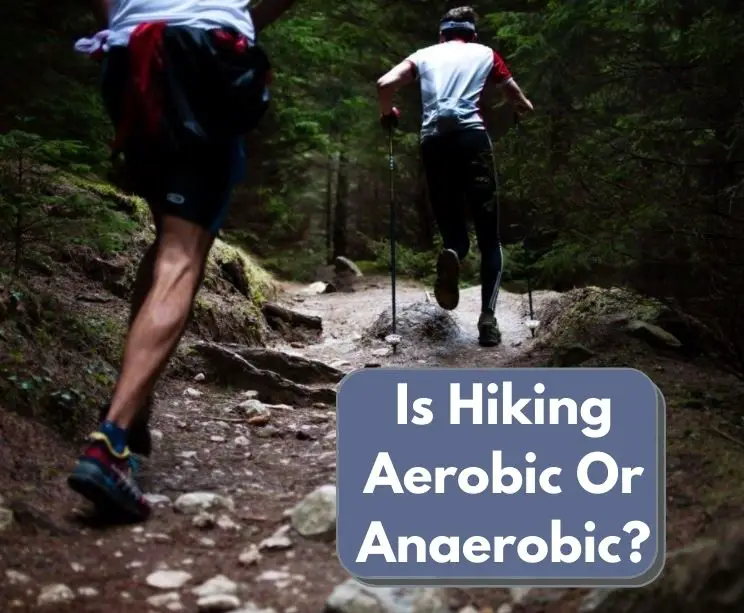As fitness comes greater into focus more than ever before across America, people are looking for ways to change up their routines and incorporate the outdoors into their exercise whenever possible. Hiking is arguably the best outdoor form of exercise due to its countless physical and mental benefits. As hiking welcomes tons of newcomers, many fitness-conscious hikers are asking: is hiking aerobic or anaerobic?
Hiking works both the aerobic (cardio) system as well as the anaerobic (muscle-building) system, making it one of the few outdoor activities that is both aerobic and anaerobic.
Hiking also helps build functional strength, increases range of motion, and improves endurance, all while being accessible to most age groups, body types, and fitness levels.

Is Hiking Aerobic Or Anaerobic?
While hiking is primarily an aerobic exercise (meaning it works the cardio system) due to elevated heart and respiration levels, it also has many anaerobic benefits (meaning it helps to build muscles).
How Is Hiking An Aerobic Activity?
Before we get into what makes hiking an aerobic activity, let’s cover what aerobic means.
Aerobic is a term used to describe energy produced with the presence of oxygen, and your aerobic system is the organs and muscles in your body that use oxygen, like your heart, lungs, and muscles.
Aerobic exercise builds up your endurance levels of the affected organs and muscles and are activities that require lots of oxygen like cycling, running, swimming, and hiking.
Because hiking elevates your heart rate and requires your lungs to take in lots of oxygen as you are constantly moving up and down hills as you hike, hiking is an aerobic activity.
Benefits Of Hiking As Aerobic Exercise
Since hiking qualifies as an aerobic activity, hiking can:
- Increase stamina
- Reduce fatigue
- Lower blood pressure
- Assist with weight management
- Increase “good” cholesterol and lower “bad” cholesterol
- Stimulate the immune system
- Improve mood
- Improve sleep
- Slow loss in bone density
How Is Hiking An Anaerobic Activity?
Let’s also cover what anaerobic means before we discuss how hiking qualifies as anaerobic exercise.
Anaerobic is a term used to describe energy produced without the presence of oxygen.
The anaerobic system (also referred to as the lactic acid system) uses stored energy in your body by breaking down glucose to fuel the body during quick and intense periods of exercise.
Anaerobic exercise helps to burn fat and build muscle and mass, and includes activities like weight lifting, plyometrics (jumping), and sprinting.
As you hike, you activate the muscles in your lower body like your quads, glutes, calves, and hamstrings to propel you up hills and over or around obstacles and on uneven terrain, which confirms that hiking is an anaerobic activity.
Benefits Of Hiking As Anaerobic Exercise
The benefits of hiking as an anaerobic activity include:
- Increased bone strength and density
- Assisted weight maintenance
- Increased power
- Boosts metabolism
- Fights depression
- Increases lactic threshold (which lowers fatigue)
- Protects joints
- Reduces risk of diabetes and heart disease
- Boosts energy

Does Hiking Count As Cardio?
The short answer is yes, hiking absolutely counts as cardio – hiking is a great way to get your heart rate up and your body moving.
The extra energy you spend going up and down hills and over uneven terrain add to the existing cardio benefits of hiking as well.
Trying to get more out of your hikes? Learn how to train for hiking on a treadmill while you’re here.
If you’re looking to add more upper body movement into your hiking, consider adding hiking poles as they help engage your arms while out on the trail.
Check out how to size hiking poles to make sure you select the proper length you need.
Is Hiking Aerobic Or Anaerobic? Wrapping Things Up
As we covered in this article, hiking is both an aerobic and anaerobic activity that combines elements of cardio and lower body muscle work to provide numerous physical and mental benefits.
The fact that this is also an outdoor and approachable activity for most ages and physical capabilities makes it a great starting point (or additional activity) for anyone looking to improve their fitness.
If you’re looking for ways to get better prepared for hiking, check out our guides on the best exercises to give you explosive power when hiking uphill, how to prepare and strengthen your knees for hiking, and how to prepare your feet for hiking.

